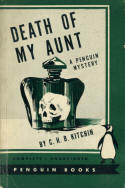
|
Penguin | |
Click the group of books beginning with number:
The Later Penguin Books (from the 60's and 70's)
|
Penguin, the first true mass market paperback published in an English-speaking country, had a good shot at becoming the first publisher of paperbacks in the United States, as well. But Allen Lane, the man behind Penguin, was extremely conservative … far too conservative for most Americans, including Ian Ballantine, his Chief of American Operations (which, at first, simply consisted of importing books printed in England and circulating them in the States). Ballantine started the American business firm in 1939 (only months after Pocket Book had published its first ten books) with a staff of three: himself, his wife, Betty, and a stock boy. The original shipments had to be carried by hand up to Ballantine's apartment in New York, where they were stored for distribution. By 1940, the "offices" had been moved once, and then moved again during the war, to accommodate the growing need for more space. In 1941, Lane visited New York, and he wasn't happy with the operation. He hired Kurt Enoch to be the firm's American vice president. With the advent of the war, Ballantine was forced out of his job as importer into the true role of publisher. First, shipments from England were endangered by U-boat attacks; and secondly, Ballantine signed a historic agreement with the Army's Military Service Publishing Company (see the Infantry Journal folder). Later, after Ballantine left, Enoch would eventually become instrumental in Penguin's transition to New American Library (Signet and Mentor). Signet distributed some reprints of their Penguin books using dust jackets, but still printed with Penguin book numbers. Jackets were also used on a few earlier paperbacks. Many of those include a U.S. price and address on imported British books. (See the Dust Jacket section.) This was nothing new. Lane wrapped several of his British books in jackets. The biggest difference of opinion in the early years probably involved the question of what should be on the covers of the books. In England, the Penguin concept of cover art was pretty straight forward. There usually was none at all; only the title and famous Penguin colophon were present on most covers. That simply wouldn’t do for the more visually-oriented Yanks. On the west side of the pond, the cover sold the work. That law of publishing economics had been firmly established by the wonderful world of pulp magazines. Covers, at first, were very simplistic. In fact, it was not until the Signet years that they became true works of art in themselves. The first American Penguin was #501, but there are a few of the pre-500 books represented in the database which were imports of earlier British books. Penguin #659 is considered the last Penguin book, though Signet reprinted it as 659A. Notice the differences between the two printings as Penguin became New American Library. The Penguin name lingered for another year (see some "Penguin/Signets" in the Signet section). In the database, a later printing of a Penguin number will often be a Signet publication. The Penguin S-series wartime books, the volumes they produced for Infantry Journal, and Superior Reprints can be viewed in the Infantry Journal folder. The Penguin name reemerged in the 1960's, and is still a major source of paperback (and hardcover) books today.
This folder was updated in July, 2022
|